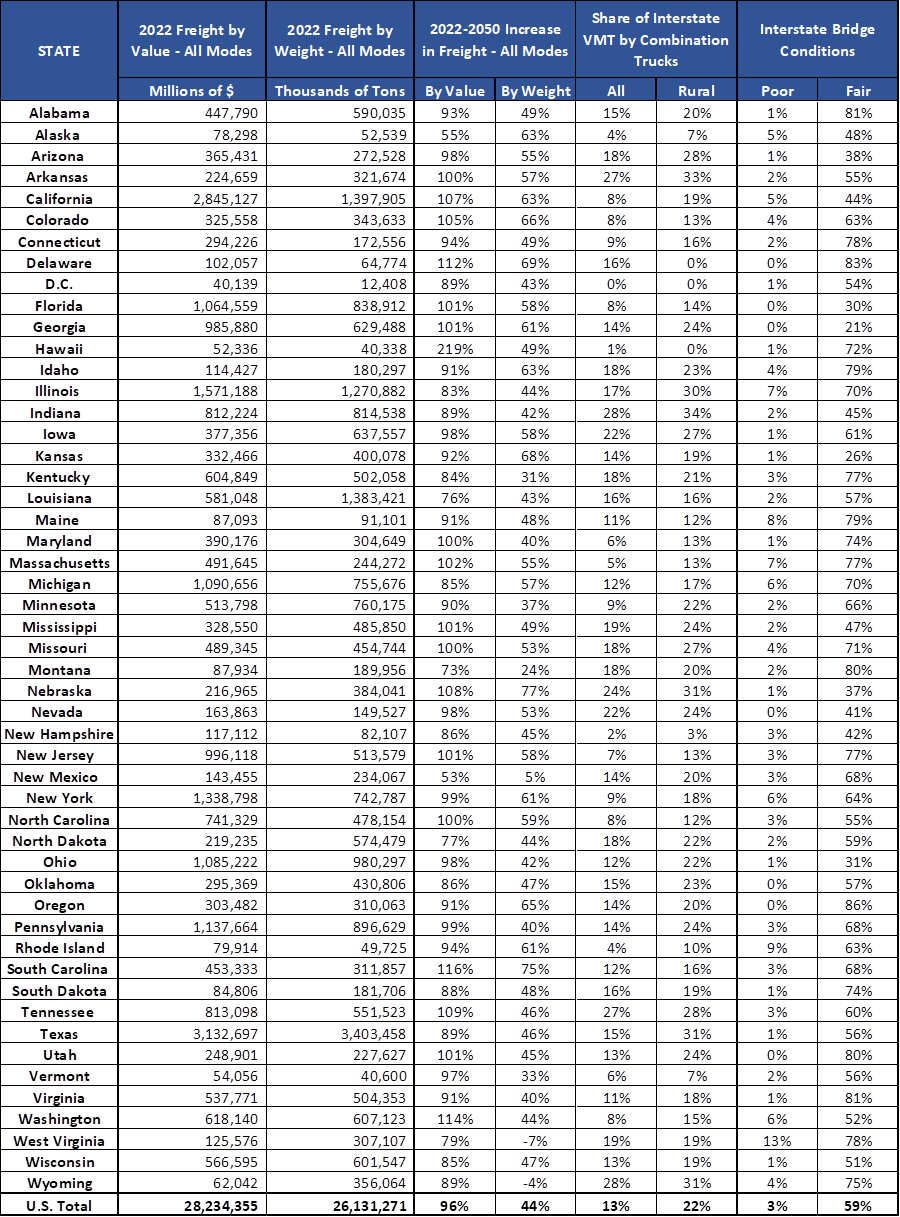The month following the collapse of a portion of Baltimore’s Francis Scott Key Bridge after it was struck by a cargo ship has highlighted the importance of the safety, reliability and condition of the nation’s freight transportation network in meeting the growing need for timely and safe movement of goods, according to TRIP, a national transportation research nonprofit based in Washington, DC.
A portion of the Francis Scott Key Bridge, which carries Interstate 695, collapsed on March 26 after being struck by the container ship Dali, resulting in the death of six construction workers and blocking access to the Port of Baltimore, the nation’s ninth largest U.S. port by overall trade volume.
According to a 2023 TRIP report, in 2022 the U.S. freight system moved 19.7 billion tons of freight, valued at $18.8 trillion, with trucks carrying 72% of freight by value and 64% by weight. From 2000 to 2022, vehicle miles of travel by large commercial trucks in the U.S. increased by 44%. From 2022 to 2050, freight moved annually in the U.S. by trucks is expected to increase 93% in value (inflation-adjusted dollars) and 47% by weight. U.S. business logistics costs reached $2.3 trillion in 2022, representing 9.1% of U.S. GDP – the highest share ever.
"The tragic collapse of the Key Bridge in Baltimore has had a significant impact on businesses across Maryland, disrupting the movement of goods and people throughout the region," said Mary D. Kane, president & CEO of the Maryland Chamber of Commerce. "This event has underscored the crucial role that our nation's infrastructure plays in supporting the daily lives of our citizens and the smooth functioning of our economy. As the unified voice of the Maryland business community, we are committed to continuing to work with our Building Bridges to Recovery Coalition, state and federal partners, as well as businesses across the state to advocate for the resources and policies needed to address these infrastructure challenges and preserve the resilience of our supply chains."
Three percent of bridges on the nation’s Interstate Highway System are rated in poor condition and another 59% are rated in fair condition. Bridges in poor condition have significant deterioration of the bridge deck, supports or other major components. A fair rating indicates that a bridge’s structural elements are sound but minor deterioration has occurred to the bridge’s deck, substructure or superstructure.
A 2019 TRB report found that the U.S. Interstate system has a persistent and growing backlog of physical and operational deficiencies as a result of age, heavy use and deferred reinvestment, and is in need of major reconstruction and modernization. The TRB report concludes that annual investment in the Interstate Highway System should be increased approximately two-and-a-half times, from $23 billion in 2018 to $57 billion annually over the next 20 years. In 2022, 13% of travel on Interstate highways and 22% of travel on rural Interstate highways was by combination trucks and 57% of large commercial truck vehicle miles of travel in 2022 was on Interstate highways.
While the amount and value of goods being shipped have risen to unprecedented levels, mounting traffic congestion is increasing the cost of moving freight and reducing the economic competitiveness and efficiency of businesses that require reliable, affordable freight transportation. Traffic congestion results in $95 billion annually in the cost of commercial trucks being stuck in traffic for 1.3 billion hours.
“The interruption in the flow of freight and travel both on Baltimore’s Key Bridge and in the channel below highlights the importance of our nation’s transportation network in safely and reliably moving goods and people,” said David Kearby, executive director of TRIP. “A transportation system that is well-maintained, safe, efficient and adequately funded is critical to our nation’s economy and the quality of life and safety of those who rely on it.”
The chart below provides state-by-state data for freight movement by value and weight, the projected increase in freight movement by value and weight from 2022-2050, the share of vehicle miles of travel (VMT) by combination trucks on the Interstate and on Rural Interstates, and the share of Interstate bridges in poor and fair condition.


_-_127500_-_adebdcc0e07d3faa22ffd6c1efa37fb9ec5e645a_yes.png)






